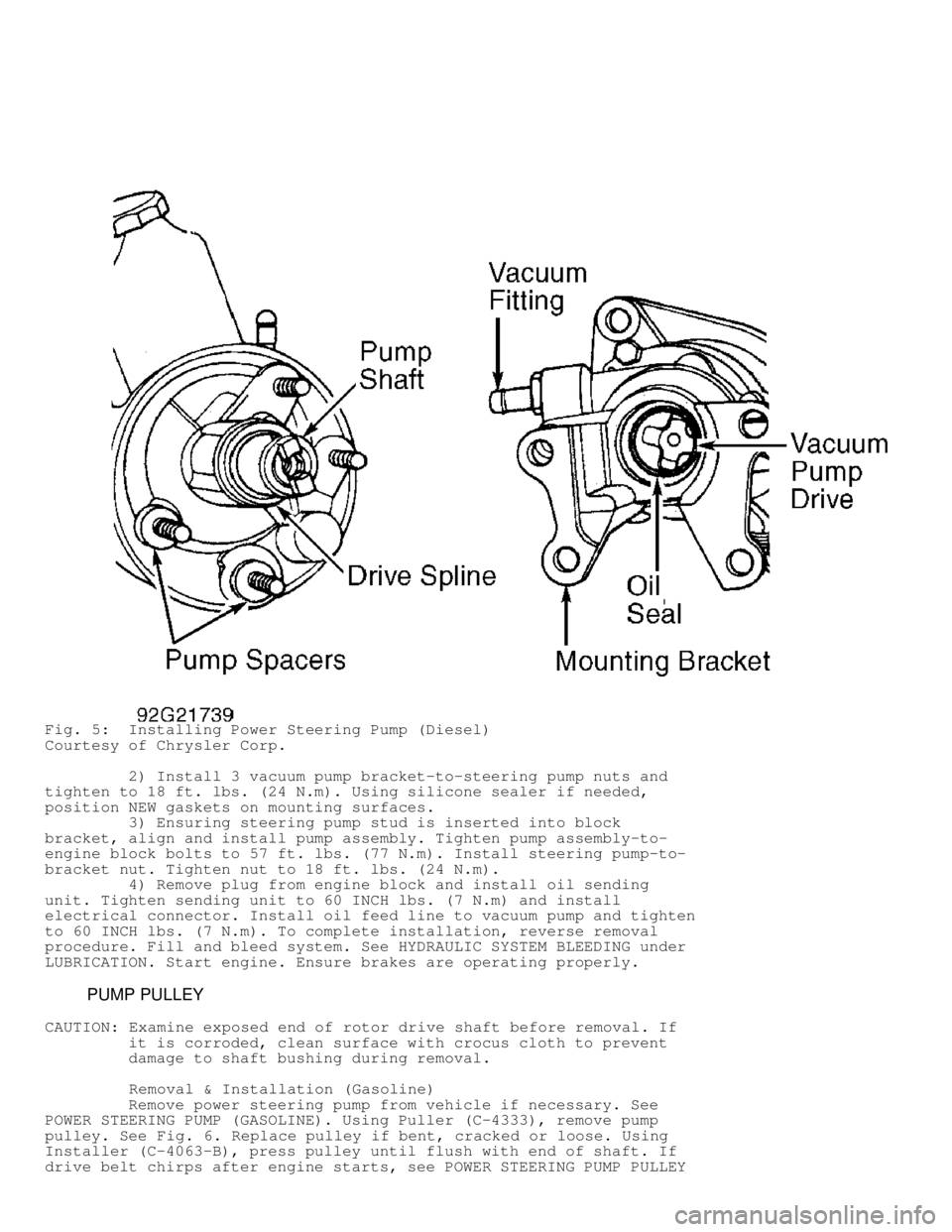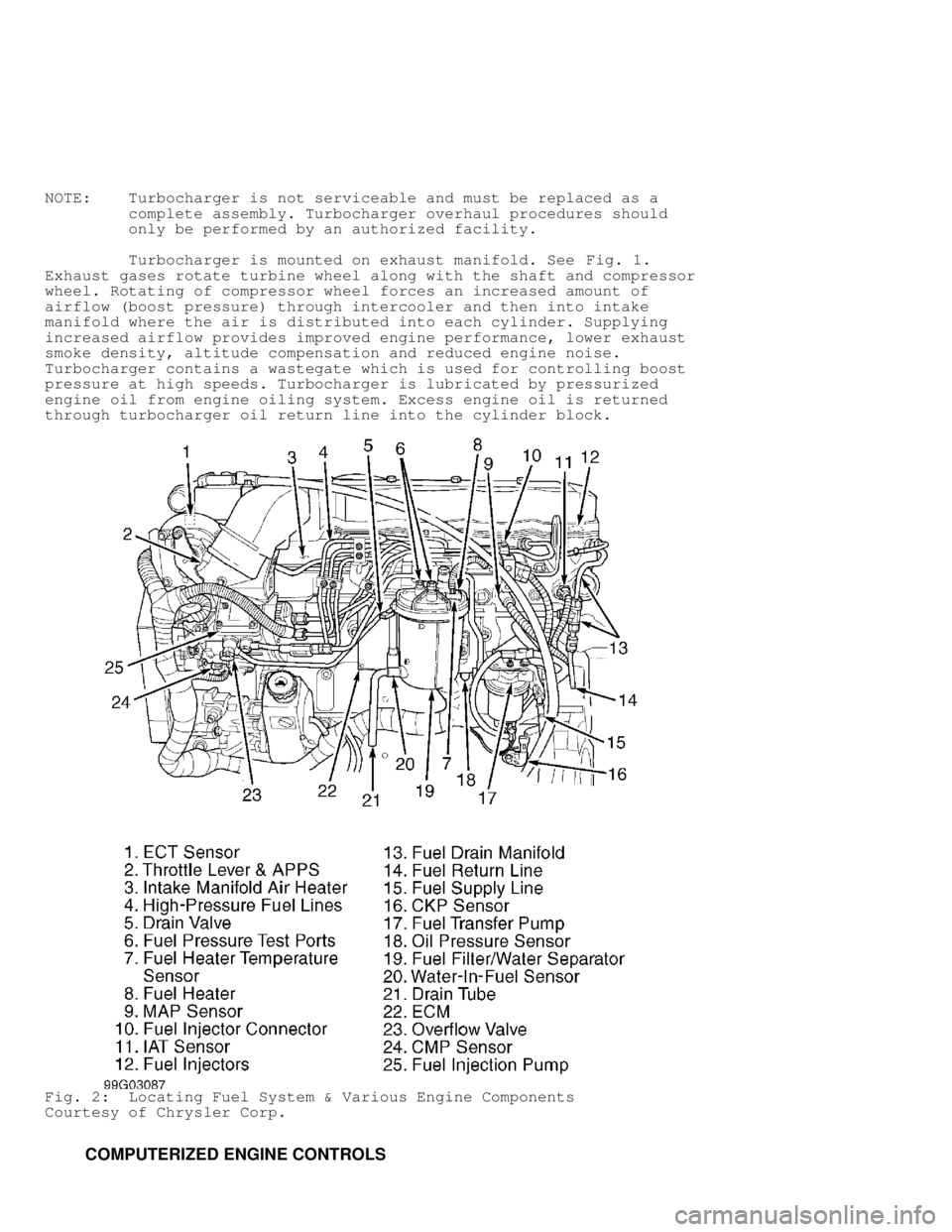1999 DODGE RAM engine oil
[x] Cancel search: engine oilPage 1251 of 1691

REMOVAL & INSTALLATION
CAUTION: When battery is disconnected, vehicle computer and memory
systems may lose memory data. Driveability problems may exist
until computer systems have completed a relearn cycle. See
the COMPUTER RELEARN PROCEDURES article in GENERAL
INFORMATION before disconnecting battery.
POWER STEERING PUMP (GASOLINE)
WARNING: DO NOT attempt to remove power steering pump without removing
power steering pump belt. Personal injury or pulley damage
could result.
Removal
1) Disconnect and isolate negative battery cable. To remove
serpentine belt, rotate tensioner clockwise and hold in place, slide
belt from tensioner pulley. Place drain pan under pump. Disconnect and
cap hoses.
2) Remove bracket-to-engine block bolts. Remove pump, pulley
and mounting bracket as an assembly. To allow access to pump screws,
remove pump pulley. See PUMP PULLEY. Remove bracket-to-pump screws.
Installation
To install pump, reverse removal procedure. Fill and bleed
system. See HYDRAULIC SYSTEM BLEEDING under LUBRICATION.
VACUUM/POWER STEERING PUMP (DIESEL)
Removal
1) Disconnect negative battery cable. Place drip pan under
vacuum/power steering pump. Disconnect and cap power brake booster
hose at vacuum pump and hydraulic lines at power steering pump.
Disconnect oil pressure sending unit electrical connector. Remove
sending unit from engine block and plug hole in block. Disconnect and
cap oil feed line from bottom of vacuum pump.
2) Remove vacuum/power steering pump-to-engine block nuts and
bolts, and mounting bracket. Remove upper pump bolt and remove pump.
Drain fluid from steering pump reservoir. Remove gaskets from mounting
surfaces.
CAUTION: DO NOT damage internal vacuum pump oil seal when separating
steering pump from vacuum pump. See Fig. 5.
3) Remove steering pump-to-vacuum pump bracket bolts.
Carefully slide steering pump from bracket. Remove 2 pump body
spacers. See Fig. 5.
NOTE: Steering pump housing and spacers must mate completely with
vacuum pump bracket.
Installation
1) Install 2 pump body spacers and rotate drive gear until
steering pump and vacuum pump drive splines align. See Fig. 5.
Carefully install steering pump on vacuum pump bracket to prevent
damaging oil seal.
Page 1252 of 1691

Fig. 5: Installing Power Steering Pump (Diesel)
Courtesy of Chrysler Corp.
2) Install 3 vacuum pump bracket-to-steering pump nuts and
tighten to 18 ft. lbs. (24 N.m). Using silicone sealer if needed,
position NEW gaskets on mounting surfaces.
3) Ensuring steering pump stud is inserted into block
bracket, align and install pump assembly. Tighten pump assembly-to-
engine block bolts to 57 ft. lbs. (77 N.m). Install steering pump-to-
bracket nut. Tighten nut to 18 ft. lbs. (24 N.m).
4) Remove plug from engine block and install oil sending
unit. Tighten sending unit to 60 INCH lbs. (7 N.m) and install
electrical connector. Install oil feed line to vacuum pump and tighten
to 60 INCH lbs. (7 N.m). To complete installation, reverse removal
procedure. Fill and bleed system. See HYDRAULIC SYSTEM BLEEDING under
LUBRICATION. Start engine. Ensure brakes are operating properly.
PUMP PULLEY
CAUTION: Examine exposed end of rotor drive shaft before removal. If
it is corroded, clean surface with crocus cloth to prevent
damage to shaft bushing during removal.
Removal & Installation (Gasoline)
Remove power steering pump from vehicle if necessary. See
POWER STEERING PUMP (GASOLINE). Using Puller (C-4333), remove pump
pulley. See Fig. 6. Replace pulley if bent, cracked or loose. Using
Installer (C-4063-B), press pulley until flush with end of shaft. If
drive belt chirps after engine starts, see POWER STEERING PUMP PULLEY
Page 1255 of 1691

Removal
1) Place wheels in straight-ahead position. Place drain pan
under steering gear assembly. Disconnect and cap pressure and return
hoses from steering gear. Disconnect steering column shaft coupling
from steering gear stub shaft.
2) Raise and support vehicle. Disconnect steering linkage
(center link) from pitman arm. See Fig. 9. Disconnect stabilizer bar
(if necessary). Place reference mark on pitman arm and sector shaft.
Remove nut and pitman arm from sector shaft. Remove steering gear-to-
frame bolts. Remove steering gear.
Installation
1) Install steering gear with bolts finger tight. Center
steering gear and align stub shaft with steering column. Install
steering column shaft coupling bolt and tighten to specification. See
TORQUE SPECIFICATIONS.
CAUTION: Stake pitman arm nut against pitman arm to ensure proper
retention.
2) Reposition steering gear to eliminate binding, and tighten
bolts to specification. Install pitman arm on sector shaft with
reference marks aligned. Install lock washer and nut. Tighten nut to
specification.
3) To install remaining components, reverse removal
procedure. Fill pump reservoir. Bleed air from hydraulic system. See
HYDRAULIC SYSTEM BLEEDING under LUBRICATION.
SECTOR SHAFT OIL SEAL
Removal
1) Raise and support vehicle. Place wheels in straight-ahead
position. Disconnect steering linkage (center link) from pitman arm.
Disconnect stabilizer bar (if necessary).
2) Place reference mark on pitman arm and sector shaft.
Remove nut and pitman arm from sector shaft. Place drain pan under
steering gear. Remove retaining ring and steel washer. See Fig. 1.
CAUTION: DO NOT hold steering wheel in left-turn position for more
than 2 seconds.
3) Start engine and momentarily hold steering wheel in
extreme left-turn position. When pressure develops, this should force
upper oil seal, steel washer and lower oil seal from steering gear
housing. Stop engine and remove seals.
Installation
1) Ensure seal bore of steering gear is free of burrs and
sector shaft is free of pitting or roughness. Lubricate replacement
seals and steel washers with power steering fluid.
2) Wrap sector shaft with plastic tape or .005" (.13 mm)
thick shim stock. Install upper oil seal (single lip seal) and steel
washer first. Oil seal must be installed only deep enough to allow for
remaining oil seal, steel washer and retaining ring.
CAUTION: DO NOT install upper oil seal against inner bore surface of
steering gear housing. Oil seals must be installed so each
oil seal is separately seated in shaft bore.
3) Install lower oil seal (double lip seal) and steel washer\
.
Oil seal must be installed only deep enough to allow for steel washer
and retaining ring. Remove tape or shim stock and install retaining
ring.
Page 1314 of 1691

WHEEL BEARING & HUB
Wheel bearing and hub assembly is not serviceable, and is
replaced as an assembly only.
REMOVAL & INSTALLATION
COIL SPRING
Removal & Installation
1) Raise and support vehicle. Position jack under axle for
added support. Scribe alignment marks on lower control arm cam
adjusters and axle bracket for installation reference.
2) Remove upper control arm. See UPPER CONTROL ARM. Loosen
lower control arm bolts. See Fig. 1. On 4WD models, scribe marks on
front drive shaft for installation reference. Disconnect front drive
shaft from axle. On all models, disconnect track bar from frame rail
bracket. See TRACK BAR. Disconnect drag link from pitman arm.
3) Disconnect stabilizer bar link and shock absorber from
axle. Lower axle until spring is free from upper mount. Remove coil
spring. To install, reverse removal procedure. Tighten nuts and bolts
to specification. See TORQUE SPECIFICATIONS table.
LOWER CONTROL ARM
Removal & Installation
1) Raise and support vehicle. Scribe alignment marks on cam
adjusters and suspension arm for installation reference. Remove lower
control arm nut, cam and cam bolt from axle. See Fig. 1.
2) Remove nut and bolt from frame rail bracket. Remove lower
control arm. To install, reverse removal procedure. Tighten nuts and
bolts to specification. See TORQUE SPECIFICATIONS table.
UPPER CONTROL ARM
Removal & Installation
1) Raise and support vehicle. Remove upper control arm nut
and bolt at axle bracket. See Fig. 1. Remove nut and bolt at front
rail and remove upper control arm assembly.
2) To install, reverse removal procedure. Tighten nuts and
bolts to specification. See TORQUE SPECIFICATIONS table.
SHOCK ABSORBER
Removal & Installation
1) Remove nut, retainer and grommet from upper stud in engine
compartment. See Fig. 2. Remove 3 nuts from upper shock bracket.
Remove lower bolt from axle bracket. Remove shock absorber from engine
compartment.
2) To install, reverse removal procedure. Tighten nuts and
bolts to specification. See TORQUE SPECIFICATIONS table.
Page 1396 of 1691

article.
POSITIVE CRANKCASE VENTILATION (PCV)
PCV Valve
1) With engine running at curb idle, remove PCV valve from
grommet. If valve is functioning properly, a hissing sound will be
heard as air passes through valve.
2) With engine running, place finger over valve inlet. Strong
vacuum should be felt at valve inlet. Stop engine. Remove and shake
PCV valve to ensure a metallic clicking noise can be heard, indicating
valve is free. Reinstall PCV valve.
3) Remove crankcase ventilation filter or oil filler cap from
valve cover. Hold a piece of stiff paper over opening. After allowing
about one minute for crankcase pressure stabilization, paper should be
drawn against opening.
4) If paper is held against opening, performance is okay. If
paper is not held against opening, replace PCV valve and retest. If
performance does not improve, inspect system for restrictions and
clean as necessary.
MISCELLANEOUS CONTROLS
NOTE: Although the controlled devices listed here are not
technically engine performance components, they can affect
driveability if they malfunction.
RELAYS
A/C Clutch Relay
See A/C CLUTCH RELAY under RELAYS.
Radiator Fan Control Relay
See RADIATOR FAN CONTROL RELAY under RELAYS.
Torque Converter Clutch (TCC) Relay
See TORQUE CONVERTER CLUTCH (TCC) RELAY under RELAYS
Transmission Governor Pressure Solenoid Relay
See TRANSMISSION GOVERNOR PRESSURE SOLENOID RELAY under
RELAYS.
Transmission 12-Volt Supply Relay
See TRANSMISSION 12-VOLT SUPPLY RELAY under RELAYS.
Vehicle Speed Control Relay
See VEHICLE SPEED CONTROL RELAY under RELAYS.
Page 1460 of 1691

NOTE: Turbocharger is not serviceable and must be replaced as a
complete assembly. Turbocharger overhaul procedures should
only be performed by an authorized facility.
Turbocharger is mounted on exhaust manifold. See Fig. 1.
Exhaust gases rotate turbine wheel along with the shaft and compressor
wheel. Rotating of compressor wheel forces an increased amount of
airflow (boost pressure) through intercooler and then into intake
manifold where the air is distributed into each cylinder. Supplying
increased airflow provides improved engine performance, lower exhaust
smoke density, altitude compensation and reduced engine noise.
Turbocharger contains a wastegate which is used for controlling boost
pressure at high speeds. Turbocharger is lubricated by pressurized
engine oil from engine oiling system. Excess engine oil is returned
through turbocharger oil return line into the cylinder block.
Fig. 2: Locating Fuel System & Various Engine Components
Courtesy of Chrysler Corp.
COMPUTERIZED ENGINE CONTROLS
Page 1464 of 1691

manifold, sends input signal to Engine Control Module (ECM). ECM uses
input signal for controlling fuel control, timing and engine
protection. ECM will lower engine power if boost is too high.
Oil Pressure Sensor
Oil pressure sensor signal is input to Engine Control Module
(ECM). ECM converts signal to pressure value. Value is sent on CCD Bus\
to instrument panel gauge/light. Oil pressure sensor is located on
side of engine block, below ECM. See Fig. 2.
Power Take Off (PTO)
This input is used on vehicles equipped with a Power Take Off
(PTO) unit. When PTO is engaged, Engine Control Module (ECM) will
disable some OBD-II functions.
Water-In-Fuel (WIF) Sensor
WIF sensor is located in bottom of fuel filter/water
separator. See Fig. 2. WIF sensor delivers input signal to Engine
Control Module (ECM) when water exists in the fuel filter/water
separator. As water level increases, resistance across WIF sensor
decreases. ECM compares decrease in resistance to a high water
standard value. When resistance is 30,000-40,000 ohms, ECM will turn
on WATER-IN-FUEL warning light. WATER-IN-FUEL warning light is located
on instrument panel, just below tachometer. ECM monitors input signal
when ignition switch is in the ON position and continues to monitor
input signal until intake manifold air heater post-heat cycle is
complete.
PCM INPUT SIGNALS
A/C Switch
When A/C switch is in ON position, an input signal is
delivered from A/C switch to Engine Control Module (ECM) to indicate
that A/C operation has been requested. Once A/C operation has been
requested, an A/C request signal is delivered to ECM from A/C high-
pressure switch and A/C low-pressure switch. The A/C request signal
indicates evaporator pressure is within proper range for A/C
operation. ECM uses A/C request signal to cycle A/C compressor clutch
by using an A/C clutch relay. A/C clutch relay may also be referred to
as A/C compressor clutch relay. If A/C high-pressure switch or A/C
low-pressure switch opens, A/C request signal will not be delivered to
the ECM. ECM will then open ground circuit for A/C clutch relay and
A/C compressor clutch will be disengaged.
The A/C clutch relay is located in power distribution center
at driver's side front corner of engine compartment, near the battery.
The A/C high-pressure switch is located on discharge line, near A/C
compressor. The A/C low-pressure switch is located on top of
accumulator.
Accelerator Pedal Position Sensor (APPS) Output From ECM
Accelerator Pedal Position Sensor (APPS) is mounted on top
left of engine. See Fig. 2. Sensor provides DC voltage input signal to
Engine Control Module (ECM) to indicate throttle position. On previous\
engines, there were linkages between accelerator pedal, throttle
position sensor and injection pump. On this engine, no linkage exists
between accelerator pedal and injection pump. APPS signal is sent on
CCD Bus circuit from ECM to PCM.
Automatic Shutdown (ASD) Relay
A 12-volt input signal is delivered from ASD relay to Engine
Control Module (ECM) when ASD relay is energized. If ECM does not
receive a 12-volt input signal when ASD relay is energized, a
Diagnostic Trouble Code (FTC) will be stored in ECM. ASD relay is
Page 1467 of 1691

brakelines are attached to and is mounted in the engine compartment.
ECM OUTPUT SIGNALS
APPS & CKP Output To PCM
See ACCELERATOR PEDAL POSITION SENSOR (APPS) OUTPUT FROM ECM
under PCM INPUT SIGNALS.
CCD Bus
These circuits are connected between Engine Control Module
(ECM) and Powertrain Control Module (PCM) to allow communication
between modules.
DLC Output
Data Link Connector (DLC) is connected to Engine Control
Module (ECM). Using a scan tool, data can be retrieved (output) from\
ECM.
5-Volt Sensor Supply Output
Engine Control Module (ECM) supplies a 5-volt reference
signal to the following sensors:
* Crankshaft Position (CKP) Sensor
* Camshaft Position (CMP) Sensor
* Intake Air Temperature (IAT) Sensor
* Engine Oil Pressure Sensor
* Manifold Absolute Pressure (MAP) Sensor
Engine Control Module (ECM) also supplies voltage to the
following sensors:
* Accelerator Pedal Position Sensor (APPS)
* Intake Air Temperature (IAT) Sensor
* Engine Oil Pressure Sensor
* Engine Coolant Temperature (ECT) Sensor
* Manifold Absolute Pressure (MAP) Sensor
* Water-In-Fuel (WIF) Sensor
Fuel Injection Pump Relay
The Engine Control Module (ECM) energizes the fuel injection
pump and integral Fuel Pump Control Module (FPCM) through the relay.
When ignition is turned on, ECM supplies 12 volts to fuel injection
pump relay, located in Power Distribution Center.
Fuel Pump Control Module (FPCM)
Fuel Pump Control Module (FPCM) controls fuel pump using
inputs from Engine Control Module (ECM). FPCM is integral to top of
fuel pump. ECM and FPCM are interconnected together for fuel injection
control.
Fuel Transfer Pump
Engine Control Module (ECM) supplies power to fuel transfer
pump. Transfer fuel pump supplies fuel under low pressure (14 psi)
while engine is running to fuel injection pump. Fuel transfer pump
supplies an excess of fuel to cool fuel injection pump. Excess fuel is
returned to fuel tank by fuel injection pump.
Intake Manifold Air Heater Relays
Intake manifold air heater relays provide voltage to intake
manifold air heater for warming of intake. See Fig. 5. Warming of
intake air aids in engine starting and improved driveability during
cold ambient temperatures. Intake manifold air heater relays are
mounted on inner wheelwell, below driver's side battery. See Fig. 6.